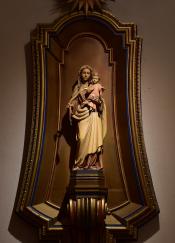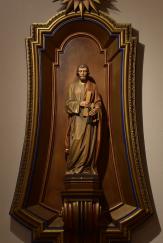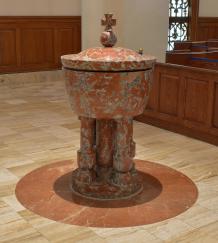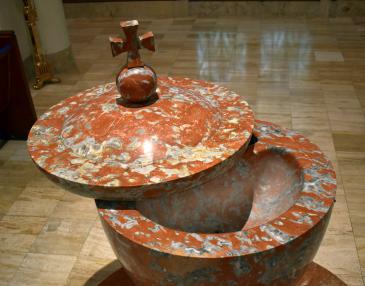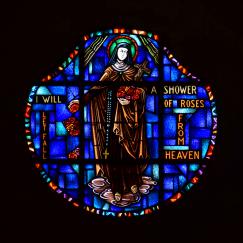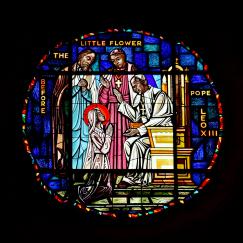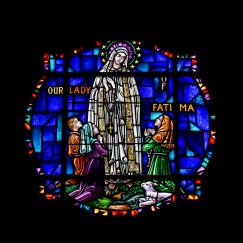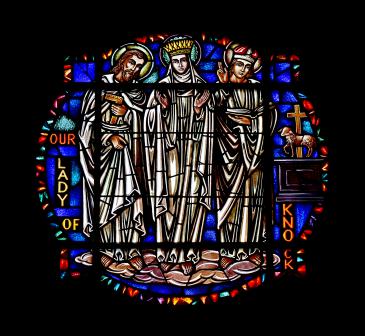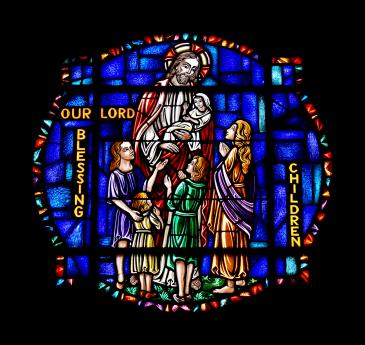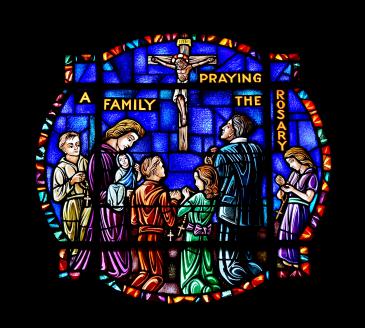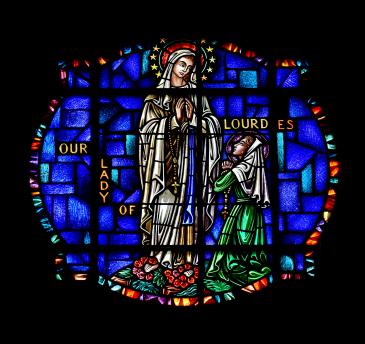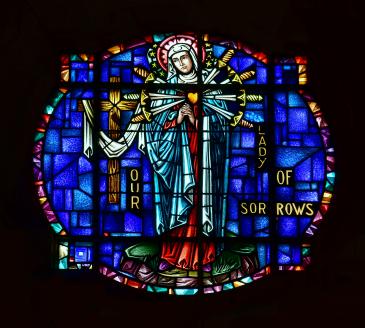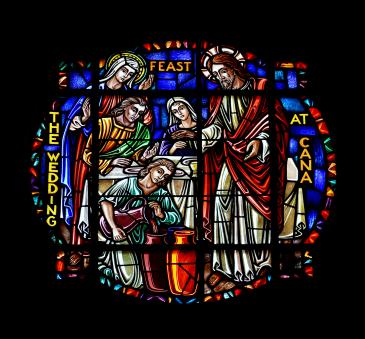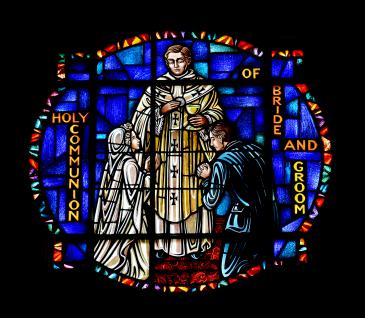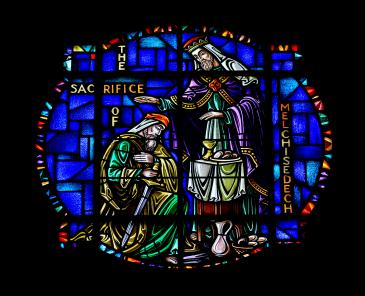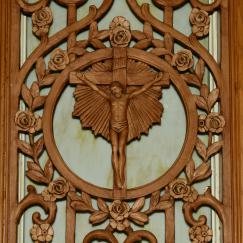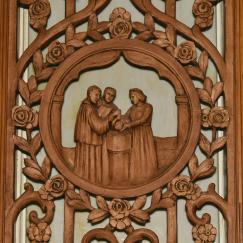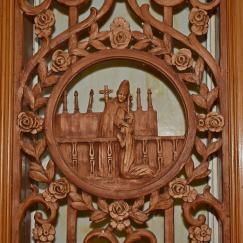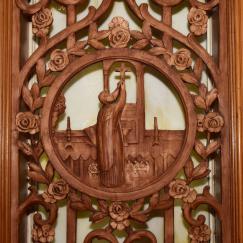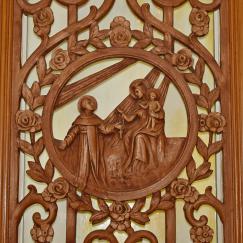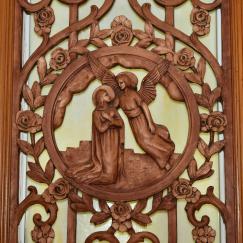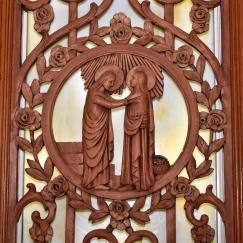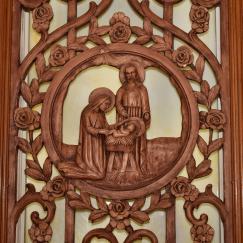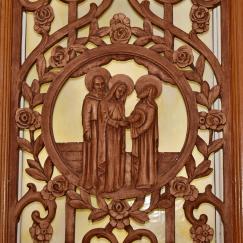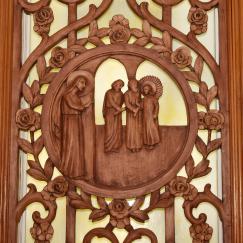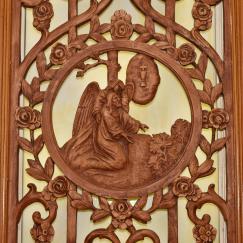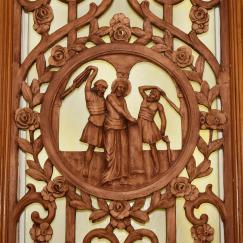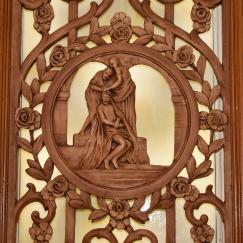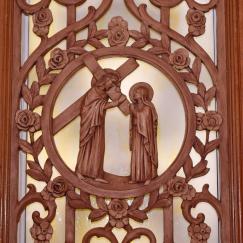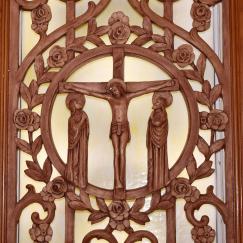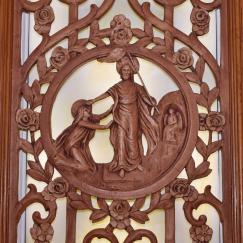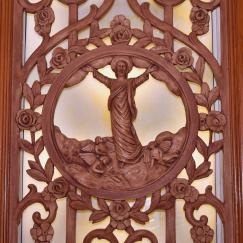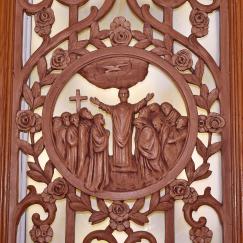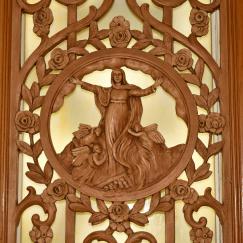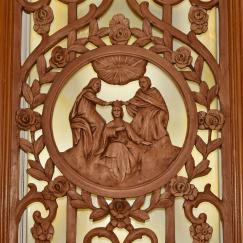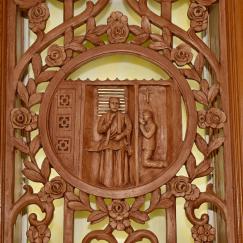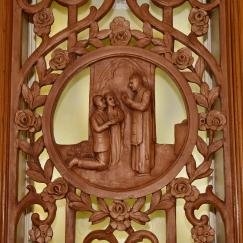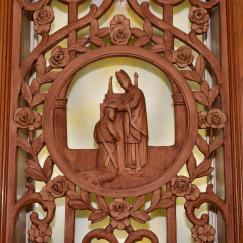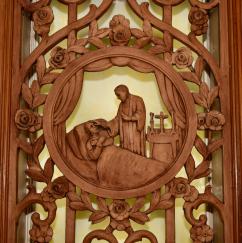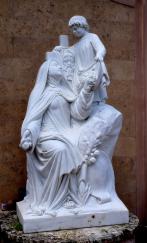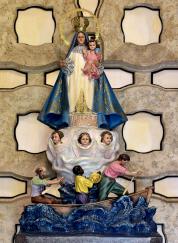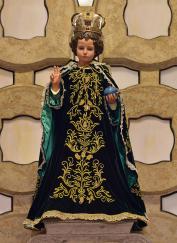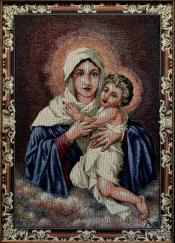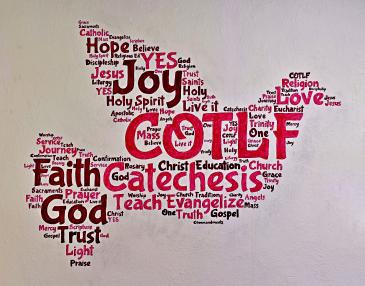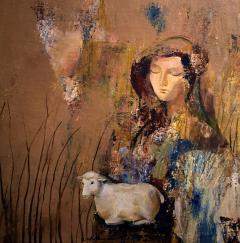By Jim Davis
- Florida Catholic
Like many churches, Little Flower in Coral Gables has a cruciform floor plan, resembling a cross from the air. The dome in the center has been compared to the heart of Christ. The first of many images of St. Therese stands above the main entrance. St. Palladius, a fifth-century Irish bishop, appears at the left of the main doors . . . . . . while his successor, St. Patrick, is at the right. Also in the narthex at Little Flower Church in Coral Gables is a full-size Sacred Heart statue. Behind him on the staircase is a window of the baptism of Christ. Statue of St. Therese, in the narthex at Little Flower Church in Coral Gables, puts her in the brown Carmelite robes of her order. Standing opposite St. Therese in the narthex is St. Anthony of Padua, like Therese a doctor of the Church. Ornate plaque in the narthex gives the dedication date in 1951 of the current building by Bishop Joseph Hurley. By then, Little Flower was more than two decades old. The reredos, the decorative screen behind the altar, bears symbols for the 12 apostles. Red, gold and bronze hues predominate inside Little Flower Church in Coral Gables. At the top of the reredos is enshrined a portrait of Therese, the church's patron saint. At the left of the chancel area is a statue of Our Lady of Mount Carmel. At the right of the chancel area is a statue of St. Joseph, often seen as the guardian of Mary's interests. Baptismal font is made of Italian marble. The cover of the font swivels aside, allowing access to a basin of water. In this clerestory window, St. Therese promises to shower roses from heaven, often taken to mean supernatural blessings. This window of St. Therese before Pope Leo XIII was repaired after a storm damaged it. Mary appears as Our Lady of Fatima to three Portuguese children. Our Lady of Knock stands with St. Joseph, holding a carpenter's square, and St. John, who took care of her after the crucifixion. They appeared to a woman in Ireland in 1879. Jesus blesses children in this window, recalling his admonition for everyone to come to him as a child. Parents and children pray the rosary before a cross in this clerestory window. St. Bernadette kneels before Our Lady of Lourdes in this window. The site of the 19th century apparitions still attracts millions of pilgrims. Seven swords, standing for the seven sorrows, pierce Mary's heart in this clerestory window. Jesus performs his public miracle, changing water into wine at a wedding feast. A couple seals their union to each other with Holy Communion during the sacrament of matrimony. King Melchizedek blesses Abraham with bread and wine in this window overlooking the chancel area. The story is told in Genesis 14. Little Flower in Coral Gables also has a series of plaster insets along the walls, illustrating the mysteries of the rosary and the seven sacraments. First is a presentation of the cross, the basis of everything else the Church does. A father and mother hold their child over a font as a priest pours holy water on its forehead, in the sacrament of baptism. A bishop anoints a kneeling child in the sacrament of Confirmation. The sacrament of Holy Eucharist recalls the Last Supper and the body and blood of Christ. In the Holy Rosary inset, Mary presents the rosary to St. Dominic Guzman, who spread the devotion in the 13th century. Here, in the first of the Joyful Mysteries, Gabriel announces to Mary that she will bear the Son of God. In the second of the Joyful Mysteries, Mary, pregnant with the Christ Child, visits Elizabeth, herself pregnant with John the Baptist. The Nativity of Jesus is the third of the Joyful Mysteries. The Holy Family present the Christ Child in the Temple in the fourth of the Joyful Mysteries. Mary finds the young Jesus conversing in the Temple in the fifth of the Joyful Mysteries. Jesus agonizes in the Garden of Gethsemane, in the first of the Sorrowful Mysteries. Roman soldiers scourge Jesus in the second of the Sorrowful Mysteries. Soldiers crown Jesus with thorns in the third of the Sorrowful Mysteries. Jesus meets his mother while carrying his cross in the fourth of the Sorrowful Mysteries. The crucifixion and death of Jesus is the fifth of the Sorrowful Mysteries. Jesus resurrects, met by Mary Magdalene, in the first of the Glorious Mysteries. The risen Jesus ascends in the second of the Glorious Mysteries. The Holy Spirit descends and fills the disciples in the third of the Glorious Mysteries. Mary is taken into heaven in the fourth of the Glorious Mysteries. Mary is crowned by the triune God as queen of heaven and earth in the fifth of the Glorious Mysteries. A priest hears confession in the sacrament of Reconciliation. A man and a woman kneel before a priest in the sacrament of Matrimony. A bishop lays hands on a candidate for ordination in the sacrament of Holy Orders. A priest blesses a bedridden person in the sacrament of the Anointing of the Sick. St. Therese adores an image of Jesus in this full-size statue, recalling her formal name, Saint Therese of the Child Jesus and the Holy Face. Statuette shows Mary appearing to three Cuban fishermen as Our Lady of Charity. The figurine is a favorite with the many Cuban members of Little Flower Church. This statuette of the Child Jesus of Prague is a replica of the original at a Carmelite church in the Czech Republic. Parishioners change the statuette�s clothing to match the liturgical seasons. Tapestry of Our Lady of Schoenstatt stands outside the chapel at Little Flower Church in Coral Gables. The Schoenstatt movement, dedicated to love for Mary, was founded by a German priest in 1914. A word cloud forms a dove on a wall in the office at Little Flower Church in Coral Gables. The mural was painted by Jorge Santibanez, director of religious education. Mary seems to share the role of Jesus as a shepherd in this painting at the offices of Little Flower Church in Coral Gables. Photography: Jim Davis
CORAL GABLES | St. Therese's namesake church in Coral Gables was founded in 1926 by then Archbishop Patrick Barry on request of a small group of Catholics in the city.
An unusual facet of Little Flower is that it was born after its parochial school. Parishioners worshiped first in the convent library of St. Joseph Academy, established in 1925 by the Sisters of St. Joseph. The school's name was changed to St. Theresa in 1932, when it won accreditation from the Southern Association of Secondary Schools.
Little Flower’s congregation got its first temporary church home, a parish center and auditorium, in 1928. Growth during the 1930s, however, forced the congregation to celebrate Mass at the nearby Tower Theater.
During World War II, parishioners assisted the Civil Defense program, giving first-aid courses, making bandages, and serving as air raid and fire wardens. After the war, the parish constructed its long awaited church in 1951.
After 65 years of service, the Sisters of St. Joseph left St. Theresa school, and the Carmelite Sisters of the Sacred Heart of Los Angeles began running the school in 1991.
The parish offers dozens of organized ministries, including blood drives, outreaches to teens and young adults, an Emmaus program, adult education Bible studies in English and Spanish, and a new bereavement ministry.
The church also has an active Respect Life group, which plans to take part in a Life Chain demonstration along U.S. 1 on Oct. 3.
